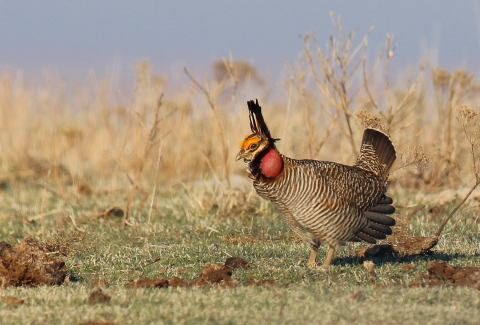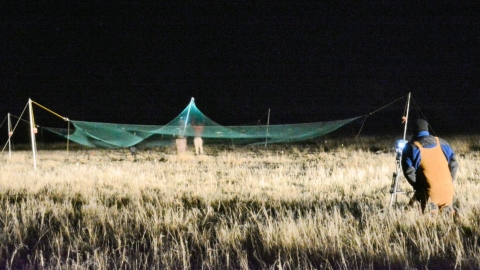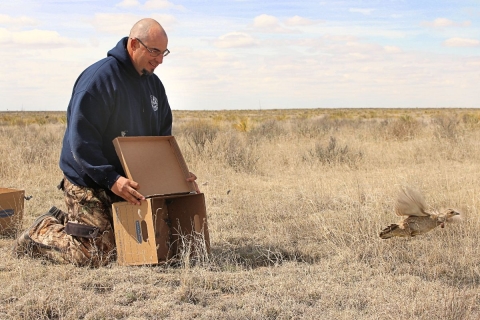The lesser prairie-chicken is a prairie grouse found in New Mexico, Texas, Colorado, Kansas, and Oklahoma. Once present in large numbers across the plains, the lesser prairie-chicken population and its original distribution area have declined significantly since the 1800s. In the twentieth century, human influences such as the conversion of native rangelands to cropland and energy development as well as severe weather significantly impacted prairie-chicken populations. Following a massive blizzard in 2006 and several years of extreme drought, the Colorado lesser prairie-chicken population had declined to an estimated 50 birds by 2016. Today, the population in southeastern Colorado is rebounding thanks to a conservation partnership between Colorado and Kansas stakeholders and funding support through the State Wildlife Grant Program.
The State Wildlife Grant (SWG) Program is administered as part of the U.S. Fish and Wildlife Service’s Wildlife and Sport Fish Restoration Program (WSFR). Established in 2001, the SWG Program provides funds to states, territories, and D.C. to address wildlife conservation needs including research, surveys, and species and habitat management. These projects focus on at-risk wildlife species as identified by the states. “The grants benefit wildlife, especially at-risk or imperiled species, often referred to as species of greatest conservation need,” said Mandi Horvath, Fish and Wildlife Biologist for WSFR. “Through a collaborative approach, the SWG Program facilitates partnerships among universities, industry, non-profit conservation organizations, and private landowners to benefit some of the nation’s most at-risk species, including the lesser prairie-chicken.”
Aided by SWG Program funds, from 2016-2019 biologists from Colorado Parks and Wildlife (CPW) and Kansas Department of Wildlife and Parks (KDWP) set out to relocate lesser prairie-chickens into the Comanche and Cimarron National Grasslands within the Sand Sagebrush Ecoregion. These grasslands, managed by the U.S. Department of Agriculture, collectively comprise over 500,000 acres of potential lesser prairie-chicken habitat. Created in 1960 to recover lands impacted by the Dust Bowl, both areas are managed for the stewardship of natural resources and wildlife habitat. “Not only were the Comanche and Cimarron known to contain numerous historic lesser prairie-chicken leks, but the National Grasslands are also collectively the largest area of public lands across the range. Additionally, the area occurs across two states, so it is a great location to partner and focus on conservation within the Sand Sagebrush Ecoregion,” said CPW Bird Conservation Coordinator, Liza Rossi. However, before the birds could be released to augment the remnant populations, biologists had to first locate and capture the unique prairie species.
Two methods were used to trap the birds in areas used during their springtime courtship display, known as a lek. One method used a funnel trap where birds walk into a metal enclosure, but cannot find their way back out. The trap works similarly to a minnow trap for fish. The second method is a drop net, where biologists set up a net over the lek and after the birds enter to start the courtship display the net is dropped. “Both of these methods are safe for the birds and we reduce as much stress as possible,” added Rossi. “We care about the health of this species and with such low numbers, every bird is important to species recovery.”
Once captured, bird weight and length are measured and some are also tested for possible disease, which ensures that relocated lesser prairie-chickens are healthy and not introducing pathogens to a new area. Each bird was also fitted with a transmitter so that biologists can monitor bird locations after release. “Not only are these relocated birds helping expand the population and distribution of the species, but they are also providing valuable insights into habitat needs and movement patterns,” said KDWP Small Game Coordinator Kent Fricke. “We can monitor the females to see the habitat type selected for their nest sites and direct management actions to provide desired vegetation for nest selection and survival.”
A total of 411 lesser prairie-chickens have been relocated and released as part of this effort. “This relocation was a true conservation partnership, with staff from state agencies in Colorado and Kansas, researchers from Kansas State University, and local landowners helping us locate and capture hundreds of birds,” added Fricke. “The SWG Program funding allowed us to purchase the equipment, assist with travel costs for the month-long trapping season each spring, and pay for staff hours to relocate the birds,” said Rossi. “The SWG Program funding was essential to provide much needed funding to hire seasonal employees to monitor the birds once in Colorado. They recorded locations, searched for nests, documented brood success and conducted vegetation measurements for this essential conservation project.”
Helping restore American wildlife and habitat will take collaborative partnerships like this lesser prairie-chicken conservation effort, but by working together stakeholders can address the challenges and benefits of restoring some of the nation’s most iconic species. “Through the SWG Program, the Service supports the boots on the ground stewardship that brings communities together,” added Horvath. “The public might not always know what projects are funded with SWG Program grants or how relocation takes place, but many understand the need to conserve and restore our wildlife and wild places.”
For information on the lesser prairie-chicken and footage of relocation efforts visit Colorado Parks and Wildlife at: cpw.state.co.us/conservation/Pages/CON-Lesser-Prairie-Chicken.aspx







